Who Created the First Work of Art to Have True Linear Perspective? What Is Its Title?
'All Art is an Illusion'
Illusion in Fine art
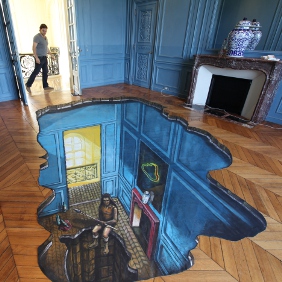
3D Joe and Max
An artist starts with a two-dimensional surface; it may exist a wall, a canvass, a board, paper or a pavement. By the use of paint or other media he must brand the viewer enter his world and share his vision. Simply the actual earth isn't two-dimensional and the artist tin't create a three dimensional globe on the surface. How do nosotros get around this problem?
The answer is illusion – to represent the three dimensional earth on the two dimensional surface the artist has to use systems of illusion that create the impression of space, of depth and of motion.
The pavement artists 3D Joe and Max (shown correct) are masters of this kind of perspective trickery, creating pavement (and floor) art that when looked at from a certain viewpoint gives a startling and visually confusing three dimensional illusion.
Art Before Perspective

The Calling of the Apostles c.1308-1311 Duccio di Buoninsegna
The organization of perspective we have for granted today is a relatively recent discovery in creative history. Earlier the 14th Century little to no attempts were made to realistically draw the three dimensional world in art in the way in which we are at present accepted to seeing it.
The art of the Byzantine, Medieval and Gothic periods was rich and cute, but the images made no endeavour to create the illusion of depth and infinite.
The Italian masters Giotto (c. 1267 – 1337) and Duccio (c. 1255-1260 – c. 1318-1319) began to explore the idea of depth and book in their art and can be credited with introducing an early form of perspective, using shadowing to great effect to create an illusion of depth, but information technology was nonetheless far from the kind of perspective we are used to seeing in fine art today.
Start Perspective – Fillipo Brunelleschi & Masaccio
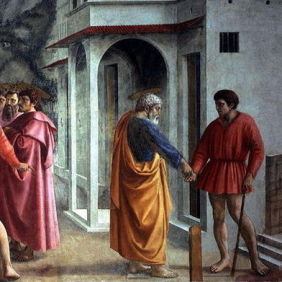
Masaccio – The Tribute Coin c.1426-27 Fresco, The Brancacci Chapel, Florence
The first known picture to make utilize of linear perspective was created by the Florentine builder Fillipo Brunelleshi (1377-1446). Painted in 1415, it depicted the Baptistery in Florence from the forepart gate of the unfinished cathedral. The linear perspective system projected the illusion of depth onto a two dimensional plane by use of 'vanishing points' to which all lines converged, at middle level, on the horizon. Soon afterward Brunelleshi's painting, the concept caught on and many Italian artists started to use linear perspective in their paintings.
Masaccio (1401 – 1428) the first great painter of the early Renaissance flow, was the first artist who demonstrated full control of the new rules of perspective; the figures in his paintings have book and the buildings and landscapes realistically recede into the altitude. Masaccio is seen now as being the initiator of the new style of Florentine Realism.
The Renaissance in Perspective
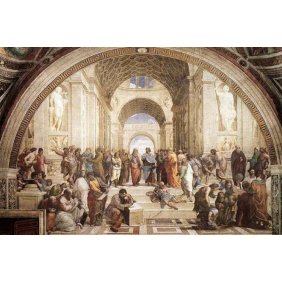
Raphael – The Schoolhouse of Athens c.1510-11 Fresco, Vatican, Stanza della Signurata
By the tardily 15th Century, artists were in full command of perpective and were able to create in their art a beautiful and realistic world. The neat painters of the time were using the system first created past Brunelleschi to wonderful consequence.
Underlying these changes in artistic method and the use of perspective was a renewed desire to describe the beauty of nature, and to unravel the axioms of aesthetics, with the works of Leonardo, Michelangelo, Raphael, Botticelli, Donatello and Titian representing artistic pinnacles that were to be much imitated past other artists.
The developments were not limited to Italian republic; in the Netherlands, a especially vibrant artistic culture developed, with the piece of work of Hugo van der Goes and Jan van Eyck having detail influence on the development of painting in Italy, particularly stylistically in terms of naturalism in representation.
Perspective Established
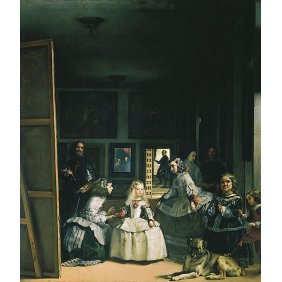
Diego Velázquez – Las Meninas – 1656–57 Oil on canvas, 318 x 276 cm
For the next five centuries, Brunelleschi'due south system of perspective was used to create the illusion of depth on the picture show plane and was used as the basis of the great art of Western civilisation.
The Baroque painters (approx. 1600-1750), notably Caravaggio, Annibale Carracci, Gianlorenzo Bernini, Rubens, Rembrandt, Velazquez and Vermeer used this now long established system in thousands of varied approaches, every bit did the Neoclassicist painters (1750-1850). The use of perspective in art to depict reality continued through the works of the Impressionists (such as Renoir, Monet and Pissarro) and was even used in the works of the Post Impressionists (such equally Vincent Van Gogh, Gauguin and Seurat).
It was around the time of the Post Impressionists yet that a meaning change in management took place.
Paul Cézanne – A Unlike Perspective
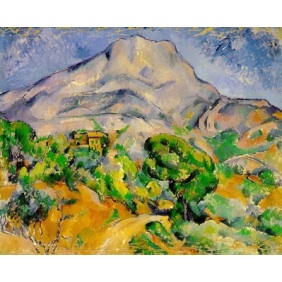
Cezanne – Mont Ste-Victoire from the Southward West – 1890-1900 Oil on canvas
Towards the end of the 19th Century French painter Paul Cézanne (1839 – 1906) began to question the underlying structure of his subjects. At points his works became almost abstracted, the canvass existence covered with thick layers of pigment often applied with a palette pocketknife, the naturally occuring forms simplified to their geometric essentials.
Importantly, Cézanne had begun to ignore the laws of classical perspective, allowing each object to be independent within the space of a motion-picture show while letting the relationship of 1 object to some other to accept precedence over traditional unmarried-point perspective.
This was possibly the get-go of the end of academic composition following the long established rules of perspective. Heavily influenced by Cezanne, several young artists were before long to radically break the mould and themselves become major influences on 20th Century art.
Pablo Picasso (1881-1973) – Form
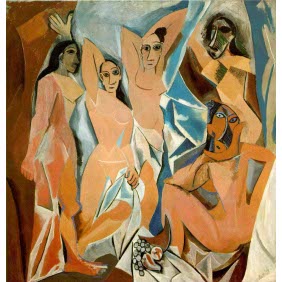
Pablo Picasso – Les Demoiselles D'Avignon – 1907 Oil on canvas – 244 x 234cm
Pablo Picasso was a towering genius of 20th century art. A brilliant draughtsman, creatively imaginative, he was 1 of the great innovators and changed the form of art history.
Born in Espana, he moved to Paris in 1904 where he associated with other ground-breaking artists such as Matisse, Derain and Braque. His early work (the Blueish and Rose periods) was cute, but substantially traditional. The painting which marked his breakaway from the traditions of perspective, "Les Demoiselles d'Avignon" was painted in 1907, merely its significance was non recognised for many years; influenced by African art and Cezanne, it is a milestone in fine art history. In the following years Picasso and Braque continued to develop the angular, structural fashion, dubbed 'Cubism' by critics. Renaissance perspective had been superseded. Picasso'southward nearly famous work, Guernica, depicts the inhumanity, brutality and hopelessness of war and is considered to be one of the major paintings of the 20th Century.
Henri Matisse (1869-1954) – Colour
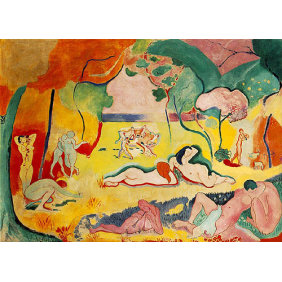
Henri Matisse – The Joy of Life – 1905-6 Oil on canvass – 175 ten 241cm
Matisse, regarded with Picasso as one of the 20th Century's greatest artists, also abandoned the traditional rules of perspective as the foundation of his work, but in a very different way.
Matisse's work was primarily an exploration of colour. After an exhibition in Paris in 1905 Matisse and a group of friends "freed colour" from naturalism and were resultantly labelled the 'Fauvists' ('wild beasts') past the critics. Based on the earth effectually him but abandoning traditional perspective, Matisse created his ain shallow space where each object was distorted and adjusted to fit its place in the overall design and bright colour was used as an independent structural object. In 1908 Matisse wrote: "I dream of an art of balance, purity and at-home, without troubling or depressing themes, that will offering… a soothing influence," and illustrated this dream in the increasingly simple form and big figures of his paintings, such as 'Joie de vivre' (shown right). This painting is a archetype example of Matisse's signature mode – flat planes of brilliant primary colours and "rhythmic, 2-dimensional" subjects.
Wassily Kandinsky (1866-1944) – Brainchild
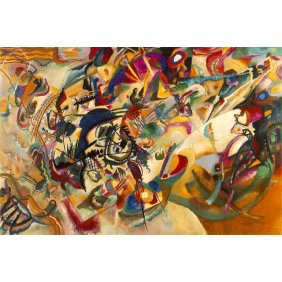
Wassily Kandinsky – Composition VII – 1913 Oil on canvas – 200 x 300cm
Wassily Kandinsky, a Russian past birth, lived and worked in Germany. Kandinsky was an accomplished artist, art theorist and musician and spent many years teaching at the Bauhaus schoolhouse until it's closure in 1933 by the Nazis, at which point he moved to Paris. Kandinsky was the showtime painter to completely abandon contact with reality and to requite form and colour alone a "spiritual significant". Kandinsky's work oftentimes appeared confused, but it had a bang-up freshness, fluidity and vitality.
Kandinsky is widely credited with creating the outset 'abstruse' art, produced post-obit a long period in which he considered and developed his ain creative theories, based often on music – music being "the ultimate teacher" – his spiritual beliefs and his own artistic experiences. Kadinsky'due south non-objective approach was echoed afterward by Piet Mondrian, Hans Arp, Frank Stella and by the Op Artists such every bit Bridget Riley and Victor Vasarely.
Piet Mondrian (1872-1944)
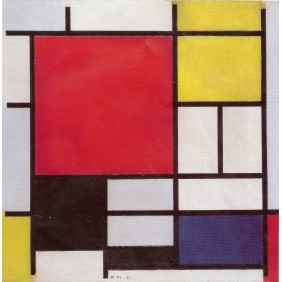
Piet Mondrian – Composition with Large Red Aeroplane, Yellowish, Blackness, Grey and Blue – 1921 Oil on sheet – 59.five x 59.5cm
Born in the Netherlands, Piet Mondrian was introduced to art at an early age by his begetter, a qualified drawing teacher. Aged xx, Mondrian entered the Academy for Fine Fine art in Amsterdam, already qualified as a teacher himself. He moved to Paris in 1912 where he immediately fell under the spell of cubist art. Although his works from this period all the same showed elements of representation, as time went on, he began to simplify his shapes and lines until, by the 1920s his work was entirely removed from any 'reality'. The forms he used were coloured squares – often just the 3 principal colours – rectangles and blackness lines.
Mondrian was very influential among the artists that followed him. His philosophy that painting should stand on its own, totally complimentary of reality and representation was a major influence on the Op Artists of the 1960s Bridget Riley and Victor Vasarely.
Kazimir Malevich (1879-1935)
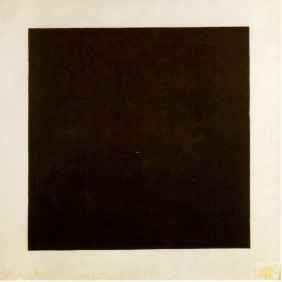
Kazimir Malevich – Black Square – 1915 Oil on canvas – 106.two 10 106.5 cm
Some other artist who felt that art needed a radical and consummate revision was Kazimir Malevich. Built-in in the Kiev Governorate of the Russian Empire and a deeply religious practicing Roman Catholic, Malevich said that he wanted to eliminate from fine art what he called 'nonsense realism'.
Malevich used elementary geometric shapes – mainly focused on the square and the circle – and limited color schemes through which he felt that he 'expressed eternity'. The movement he started was called Suprematism and began effectually 1915. Information technology was in this year that Malevich produced some of his most famous works such as 'Black Square' (shown right) and 'Black Circumvolve'. His next breakthrough came with 'White on White' in 1918 which took Suprematism from polychrome to monochrome.
Experimentation and innovation had overtaken traditional perspective as the driving force in art.
Next: Op Art History Role Ii: 'Modern Art' >>
Source: http://www.op-art.co.uk/history/perspective/
0 Response to "Who Created the First Work of Art to Have True Linear Perspective? What Is Its Title?"
Post a Comment